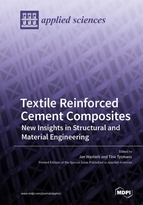Textile Reinforced Cement Composites: New Insights in Structural and Material Engineering
A special issue of Applied Sciences (ISSN 2076-3417). This special issue belongs to the section "Materials Science and Engineering".
Deadline for manuscript submissions: closed (31 March 2019) | Viewed by 53648
Special Issue Editors
Special Issue Information
Dear Colleagues,
This Special Issue welcomes new contributions in the field of textile-reinforced cement composites. These materials include cementitious matrix materials reinforced by fibre textiles (textile-reinforced concrete, textile-reinforced mortar, etc.) in such a way that they show strain hardening behavior under tensile loading. We include investigations on material, component and structural level.
Topics of interest include, but are not limited to:
- Material composition, characterisation and design
- Mechanical testing on the macro-scale (e.g. static, fatigue, impact, fire) and the micro/meso-scale (e.g. bonds)
- Analytical and numerical methods for modelling, simulation and prediction
- Design guidelines
- Innovative applications and case studies (incl. strengthening, retrofitting and repair, new structures, hybrid structures, …)
- Durability, LCA, LCC studies
- Manufacturing processes, quality control and evaluation
Prof. Dr. Jan Wastiels
Prof. Dr. Tine Tysmans
Guest Editors
Manuscript Submission Information
Manuscripts should be submitted online at www.mdpi.com by registering and logging in to this website. Once you are registered, click here to go to the submission form. Manuscripts can be submitted until the deadline. All submissions that pass pre-check are peer-reviewed. Accepted papers will be published continuously in the journal (as soon as accepted) and will be listed together on the special issue website. Research articles, review articles as well as short communications are invited. For planned papers, a title and short abstract (about 100 words) can be sent to the Editorial Office for announcement on this website.
Submitted manuscripts should not have been published previously, nor be under consideration for publication elsewhere (except conference proceedings papers). All manuscripts are thoroughly refereed through a single-blind peer-review process. A guide for authors and other relevant information for submission of manuscripts is available on the Instructions for Authors page. Applied Sciences is an international peer-reviewed open access semimonthly journal published by MDPI.
Please visit the Instructions for Authors page before submitting a manuscript. The Article Processing Charge (APC) for publication in this open access journal is 2400 CHF (Swiss Francs). Submitted papers should be well formatted and use good English. Authors may use MDPI's English editing service prior to publication or during author revisions.
Keywords
- textile
- fibre
- fabric
- cementitious matrix
- TRC
- TRM
- cement composites






